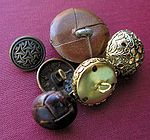Button: Difference between revisions
Violetriga (talk | contribs) |
vote for this article to be improved by WP:AID |
||
| Line 1: | Line 1: | ||
<div style="text-align: center; margin: 0 10%;"> |
|||
{| id="{{{id}}}" style="background: #FFE4E1; border: 2px solid #DB7093; margin: 0 auto;" |
|||
|- |
|||
| [[Image:Aidlogo.png|40px| ]] |
|||
| '''This article has been nominated for [[Wikipedia:This week's improvement drive|the improvement drive]]!''' <br> <small>Please see [[Wikipedia:This week's improvement drive#Nominations|this page's entry]] to vote or comment.</small> |
|||
|} |
|||
</div> |
|||
:''For other uses of the word '''button''', see [[Button (disambiguation)]].'' |
:''For other uses of the word '''button''', see [[Button (disambiguation)]].'' |
||
Revision as of 11:15, 18 January 2006
| This article has been nominated for the improvement drive! Please see this page's entry to vote or comment. |
- For other uses of the word button, see Button (disambiguation).


A button is small disc- or knob-shaped object attached to cloth or an article of clothing in order to secure an opening, or for ornamentation. Functional buttons work by slipping the buttons through a fabric or thread loop, or by sliding the button through a slit called a buttonhole.
Buttons may be manufactured from an extremely broad variety of materials, including horn, shell, bone and antler, ivory, metal, plastic, celluloid, glass, thread, and wood.
Buttons and button-like objects used as ornaments rather than fasteners have been discovered in Bronze Age sites in China and are attested in Ancient Rome. Functional buttons for clothing became widespread with the rise of snug-fitting clothing in 13th and 14th century Europe.
Types of buttons
- Shank buttons have a small ring or a bar with a hole called the shank protruding from the back of the button, through which thread is sewn to attach the button.
- Covered buttons are fabric-covered forms with a separate back piece that secures the fabric over the knob.
- Flat or sew-through buttons have two or four holes punched through the button through which the thread is sewn to attach the button. Flat buttons may be attached by sewing machine rather than by hand, and may be used with heavy fabrics by working a thread shank to extend the height of the button above the fabric.
- Worked or cloth buttons are created by embroidering or crocheting tight stitches (usually with linen thread) over a knob or ring called a form.
Button sizes
Buttons are measured in lignes or lines, with 40 lignes equal to 1 inch.
Types of buttonholes

- A worked buttonhole has raw (cut) edges finished with hand sewing, usually in a buttonhole stitch.
- A machine-made buttonhole is usually sewn with two parallel rows of machine sewing in a narrow zig-zag stitch, with the ends finished in a broader zig-zag stitch.
- A bound buttonhole's raw edges are encased in a piece of fabric or trim.
- A keyhole buttonhole is a worked or machine-made buttonhole with a round hole at the end of the slit to accommodate the button's shank without distorting the fabric; keyhole buttonholes are most often found on tailored coats and jackets.
- A bar is a row of perpendicular hand or machine stitching to reinforce the ends of a buttonhole.
See also
Additional images
Buttoned doublet, later 16th century.
References
Carl Kohler, A History of Costume, Dover 1963 reprint, ISBN 0486210308
Bryan Bunch, The History of Science and Technology, Houghton Mifflin Books, 2004 ISBN 0618221239
Michael Loewe and Edward L Shaughnessy, eds., The Cambridge History of Ancient China, 1999, ISBN 052147030
